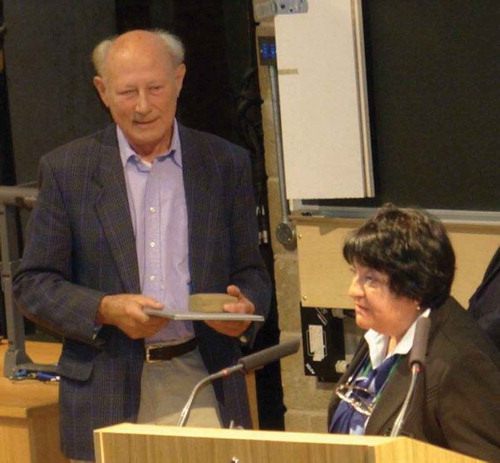This past summer in Dublin, Prof. Wolfgang Haase from the Technical University of Darmstadt, Germany, received the prestigious Frederick Medal from Sofia Torgova for his outstanding results in the field of Liquid Crystal physical chemistry. The medal has been awarded since 1996 to 25 renowned scientists in the area of Liquid Crystal Chemistry. The award is given by the Russian Liquid Crystal Society, as recognition of his long scientific career in the field of liquid crystals. Prof. Haase started his professional life being educated as a chemical worker in a factory. He then studied chemical engineering at the University of Magdeburg, where he obtained his diploma in 1957. In addition, Wolfgang studied chemistry at the University of Jena receiving his diploma in 1960. Obtaining the diploma allowed him to be eligible for the doctoral degree at the same university, which he was awarded in 1964. His ‘habilitation’ in Physical Chemistry and Structural Chemistry was granted in 1970 by the University of Marburg. Wolfgang spent several post-doctorates in Sweden, namely in Stockholm, Göteborg, Uppsala and finally back in Marburg, Germany, specialising in structural chemistry and crystallography. Since 1971 Haase worked as a professor of Physical Chemistry at the Technical University of Darmstadt, Germany.
Figure 1. Prof. Wolfgang Haase receiving the Freedericksz Medal of the Russian Liquid Crystal Society.

Since 1976, with his publication ‘Determination of the frequency of dielectric isotropy as a function of temperature by light transmission measurements’, published together with D. Potzsch in the journal Physics Letters, Haase has been strongly engaged with the study of the properties of liquid crystals.
He is a member of the Deutsche Bunsengesellschaft für Physikalische Chemie, the Deutsche Kristallographische Gesellschaft, the American Chemical Society, the Materials Research Society, the Optical Society of America and, of course, the International Liquid Crystal Society. His fields of research range from liquid crystals to non-linear optics in polymers, magnetism in inorganic compounds to bioinorganic chemistry. In his career, he established numerous international cooperations in Europe, America and Asia. His achievement in the scientific community has been well recognised, being guest Professor in 1997 at the University of Jena in Germany and visiting Professor in several countries, among them the USA, Brazil, Japan, Russia, Poland Egypt, Chile and India.
Wolfgang has contributed to many fields of research, with over 670 publications covering different topics. About 400 of his scientific publications are related to studies of low molar mass and polymer liquid crystals. He studied many properties, like magnetisms, structural characterisation, ferroelectricity, non-linear optics and also applications of these materials. The last resulted in thirteen patents. With one of them Tetragon LC Chemie AG was created. Wolfgang’s influential contribution relates mainly to the study of polar organic materials or ferroelectric liquid crystals (FLCs), with more than 200 peer-reviewed scientific papers. This contribution is reflected by the studies of ferroelectrics as co-editor of ‘Relaxation Phenomena’ (Springer Verlag) together with his friend Stanislaw Wrobel, who sadly passed away in September last year.
His contributions to the field of liquid crystals involve the thermoanalytic, structural, dielectric, electro-optic and magnetic investigations, showing a special interest in developing the field of metallomesogens. In this area he uses his expertise of the structural characterisation of crystals and magnetic properties with which he was primarily engaged at the beginning of his career. As he once told me, to begin the work in liquid crystals is a natural consequence and his own curiosity when working with the elucidation of structural characterisation in crystals. This curiosity has never faded and currently Wolfgang is investigating FLC-nanodispersions.
His work in the field of condensed materials is reflected in strong contributions not just in physical chemistry, but also in physics, chemistry and electronic engineering of liquid crystals. Managing his laboratory Wolfgang has been versatile, allowing that all kinds of scientific interactions occur. From that point of view he has hosted more than 100 colleagues in his group, many of them, about 35, from Russia. A Hirsch factor of 47 and more than 10,000 citations qualify him to be recognised as an outstanding and truly unique scientist in condensed materials.
To be awarded the Frederick Medal is a tremendous honour for Wolfgang, a recognition of almost 40 years dedicated to the work on liquid crystals. Everybody who knows his scientific work, laboratory and the tremendous efforts to keep in touch with everybody is very pleased about this tribute by the Russian Liquid Crystal Society.
